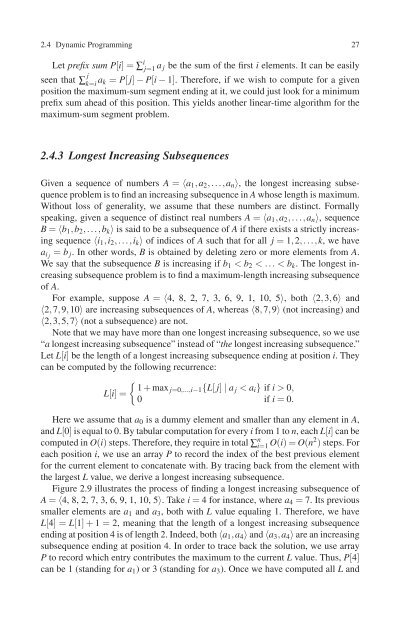You also want an ePaper? Increase the reach of your titles
YUMPU automatically turns print PDFs into web optimized ePapers that Google loves.
2.4 Dynamic Programming 27<br />
Let prefix sum P[i]=∑ i j=1 a j be the sum of the first i elements. It can be easily<br />
seen that ∑ j k=i a k = P[ j] − P[i − 1]. Therefore, if we wish to compute for a given<br />
position the maximum-sum segment ending at it, we could just look for a minimum<br />
prefix sum ahead of this position. This yields another linear-time algorithm for the<br />
maximum-sum segment problem.<br />
2.4.3 Longest Increasing Subsequences<br />
Given a sequence of numbers A = 〈a 1 ,a 2 ,...,a n 〉, the longest increasing subsequence<br />
problem is to find an increasing subsequence in A whose length is maximum.<br />
Without loss of generality, we assume that these numbers are distinct. Formally<br />
speaking, given a sequence of distinct real numbers A = 〈a 1 ,a 2 ,...,a n 〉, sequence<br />
B = 〈b 1 ,b 2 ,...,b k 〉 is said to be a subsequence of A if there exists a strictly increasing<br />
sequence 〈i 1 ,i 2 ,...,i k 〉 of indices of A such that for all j = 1,2,...,k, wehave<br />
a i j<br />
= b j . In other words, B is obtained by deleting zero or more elements from A.<br />
We say that the subsequence B is increasing if b 1 < b 2 < ... < b k . The longest increasing<br />
subsequence problem is to find a maximum-length increasing subsequence<br />
of A.<br />
For example, suppose A = 〈4, 8, 2, 7, 3, 6, 9, 1, 10, 5〉, both 〈2,3,6〉 and<br />
〈2,7,9,10〉 are increasing subsequences of A, whereas 〈8,7,9〉 (not increasing) and<br />
〈2,3,5,7〉 (not a subsequence) are not.<br />
Note that we may have more than one longest increasing subsequence, so we use<br />
“a longest increasing subsequence” instead of “the longest increasing subsequence.”<br />
Let L[i] be the length of a longest increasing subsequence ending at position i.They<br />
can be computed by the following recurrence:<br />
{ 1 + max<br />
L[i]=<br />
j=0,...,i−1 {L[ j] | a j < a i } if i > 0,<br />
0 if i = 0.<br />
Here we assume that a 0 is a dummy element and smaller than any element in A,<br />
and L[0] is equal to 0. By tabular computation for every i from 1 to n, each L[i] can be<br />
computed in O(i) steps. Therefore, they require in total ∑ n i=1 O(i)=O(n2 ) steps. For<br />
each position i, we use an array P to record the index of the best previous element<br />
for the current element to concatenate with. By tracing back from the element with<br />
the largest L value, we derive a longest increasing subsequence.<br />
Figure 2.9 illustrates the process of finding a longest increasing subsequence of<br />
A = 〈4, 8, 2, 7, 3, 6, 9, 1, 10, 5〉. Takei = 4 for instance, where a 4 = 7. Its previous<br />
smaller elements are a 1 and a 3 , both with L value equaling 1. Therefore, we have<br />
L[4] =L[1]+1 = 2, meaning that the length of a longest increasing subsequence<br />
ending at position 4 is of length 2. Indeed, both 〈a 1 ,a 4 〉 and 〈a 3 ,a 4 〉 are an increasing<br />
subsequence ending at position 4. In order to trace back the solution, we use array<br />
P to record which entry contributes the maximum to the current L value. Thus, P[4]<br />
can be 1 (standing for a 1 ) or 3 (standing for a 3 ). Once we have computed all L and

















